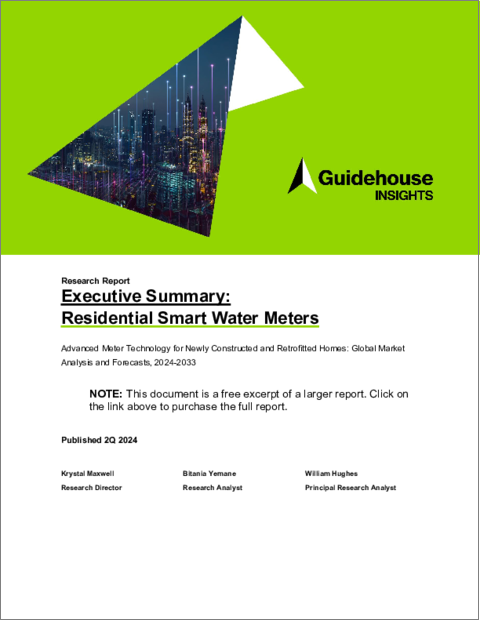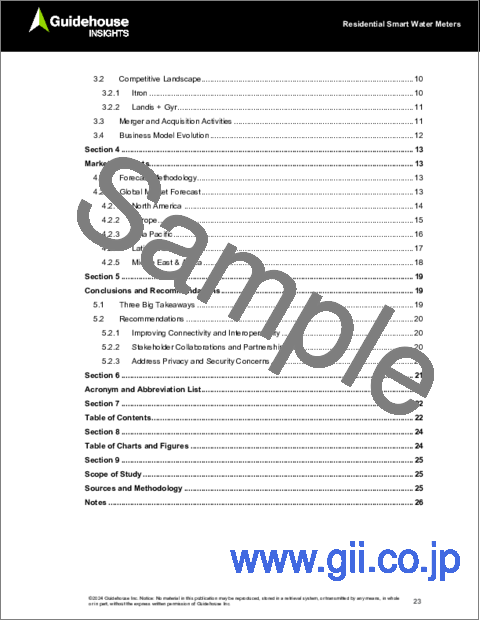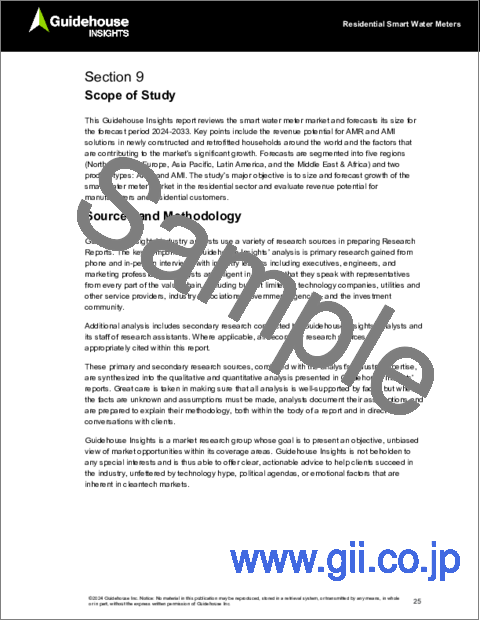|
|
市場調査レポート
商品コード
1496157
住宅用スマート水道メーターResidential Smart Water Meters - Advanced Meter Technology for Newly Constructed and Retrofitted Homes: Global Market Analysis and Forecasts, 2024-2033 |
||||||
|
|||||||
| 住宅用スマート水道メーター |
|
出版日: 2024年06月17日
発行: Guidehouse Research
ページ情報: 英文 27 Pages; 25 Tables, Charts & Figures
納期: 即納可能
|
全表示
- 概要
- 図表
- 目次
世界の住宅用スマート水道メーター市場は、予測期間中 (2024~2033年) に成長が見込まれ、ユーティリティや顧客・スマートメーターメーカーに直接的な利益をもたらします。この技術は、節水需要の高まりに伴い、コスト削減と水使用量の管理を目指す水道事業者への訴求力を高めています。AIを搭載したプラットフォームは、潜在的な問題を特定しながら、請求のためのデータ収集を迅速かつ効果的に処理するメーター技術を再構築しています。
気候パターンの変化により乾燥地域で水不足や深刻な干ばつが発生する中、節水需要の高まりがスマート水道メーター市場を牽引しています。プライバシーやセキュリティの問題、初期投資コストの高さなど、スマート水道メーターに対する阻害要因は依然として残っていますが、都市化や、自動検針 (AMR)・高度計測インフラ (AMI) ソリューションの台頭が、今後10年間の市場を牽引すると思われます。普及を目指す業界各社は、ハイエンドの通信ネットワークに投資しながら、強固なセキュリティ対策を実施する必要があります。Guidehouse Insights社は、世界のスマート水道メーター市場は2024年の30億米ドル超から2033年には50億米ドル超に成長すると予測しています。
当レポートでは、世界の住宅用スマート水道メーター市場を2つの製品種類別 (AMR・AMI) に分析し、主な利用事例や市場機会・課題、世界全体および各地域の収益予測 (2033年まで) などを掲載しています。
目次
第1章 エグゼクティブサマリー
第2章 市場課題
- 市場促進要因
- 水資源保全の必要性の増大
- 政府の取り組みと規制
- 都市化と水使用量の増加
- スタッフの時間とコストの削減
- 技術進歩
- 抑制要因
- 高額な初期投資と継続的な整備
- プライバシーとセキュリティに関する懸念
- 標準化の欠如
- 技術的課題
- 変化への抵抗
- 価格
- その他のビジネス上の問題
- IoTとクラウド技術の統合
- 人工知能
- AMIの出現
- CEO 360度ビュー
第3章 産業バリューチェーン
- スマート水道メーターのバリューチェーン
- AMR (自動検針)
- AMI (高度計測インフラ)
- 競合情勢
- Itron
- Landis + Gyr
- 企業合併・買収 (M&A) 活動
- ビジネスモデルの進化
第4章 市場予測
- 予測手法
- 世界市場の予測
- 北米
- 欧州
- アジア太平洋
- ラテンアメリカ
- 中東・アフリカ
第5章 結論・提言
- 3つの大きなポイント
- 推奨事項
- 接続性と相互運用性の向上
- ステークホルダーの協力とパートナーシップ
- プライバシーとセキュリティの懸念への対処
第6章 頭字語・略語の一覧
第7章 目次
第8章 図表
第9章 調査範囲、情報源・調査手法、注釈
List of Tables
- Smart Water Meter Revenue by Region, World Markets: 2024-2033
- Smart Water Meter Revenue by Residential Building Type, World Markets: 2024-2033
- Smart Water Meter Revenue by Meter Type, World Markets: 2024-2033
- Smart Water Meter Revenue by Residential Building Type, North America: 2024-2033
- Smart Water Meter Revenue by Product Type, North America: 2024-2033
- Smart Water Meter Revenue by Residential Building Type, Europe: 2024-2033
- Smart Water Meter Revenue by Product Type, Europe: 2024-2033
- Smart Water Meter Revenue by Residential Building Type, Asia Pacific: 2024-2033
- Smart Water Meter Revenue by Product Type, Asia Pacific: 2024-2033
- Smart Water Meter Revenue by Residential Building Type, Latin America: 2024-2033
- Smart Water Meter Revenue by Product Type, Latin America: 2024-2033
- Smart Water Meter Revenue by Residential Building Type, Middle East & Africa: 2024-2033
- Smart Water Meter Revenue by Product Type, Middle East & Africa: 2024-2033
Pricing Elements for a Smart Water Meter System
CEO 360 Degree View
Total Market: Competitive Structure
List of Figures
- Smart Water Meter Revenue by Region, World Markets: 2024-2033
- Smart Water Meter Revenue by Product Type, North America: 2024-2033
- Smart Water Meter Revenue by Product Type, Europe: 2024-2033
- Smart Water Meter Revenue by Product Type, Asia Pacific: 2024-2033
- Smart Water Meter Revenue by Product Type, Latin America: 2024-2033
- Smart Water Meter Revenue by Product Type, Middle East & Africa: 2024-2033
AMI Value Chain
Smart Water Meter Business Model Evolution
The market for residential smart water meters is expected to experience global growth during this report's 2024-2033 forecast period, which will directly benefit utilities, customers, and smart meter manufacturers. The technology has increasingly appealed to water utilities looking to reduce costs and manage water usage as the demand for water conservation rises. AI-powered platforms are reshaping how meter technology is quickly and effectively processing data collection for billing, while identifying potential issues.
A rising demand in water conservation is driving the market for smart water meters as shifting climate patterns result in water scarcity and severe droughts in arid regions. While barriers to smart water meters remain-including privacy and security issues and high initial investment costs-urbanization and emerging automatic meter reading (AMR) and advanced metering infrastructure (AMI) solutions will drive the market over the next decade. Industry players wanting to increase adoption must implement strong security measures while investing in high end communication networks. Guidehouse Insights expects the global smart water meter market to grow from more than $3.0 billion in 2024 to more than $5.0 billion in 2033.
This Guidehouse Insights report analyzes the global market for smart water meters, segmented by two product types: AMR and AMI. It provides an analysis of the market issues, including business cases, opportunities, and implementation challenges, associated with smart water meters. Global market forecasts for revenue, broken out by segment and region, extend through 2033.
Table of Contents
1. Executive Summary
- 1.1 Market Introduction
- 1.2 Report Scope
- 1.3 Market Highlights
2. Market Issues
- 2.1 Market Drivers
- 2.1.1 Rising Demand for Water Conservation
- 2.1.2 Government Initiatives and Regulations
- 2.1.3 Growth in Urbanization and Water Usage
- 2.1.4 Reduction of Staff Time and Costs
- 2.1.5 Technological Advances
- 2.2 Barriers
- 2.2.1 High Initial Investments and Ongoing Maintenance
- 2.2.2 Privacy and Security Concerns
- 2.2.3 Lack of Standardization
- 2.2.4 Technical Challenges
- 2.2.5 Resistance to Change
- 2.3 Pricing
- 2.4 Other Business Issues
- 2.4.1 Integration of IoT and Cloud Technology
- 2.4.2 AI
- 2.4.3 AMI Emergence
- 2.5 CEO 360 Degree View
3. Industry Value Chain
- 3.1 Value Chain for Smart Water Meters
- 3.1.1 AMR
- 3.1.2 AMI
- 3.2 Competitive Landscape
- 3.2.1 Itron
- 3.2.1 Landis + Gyr
- 3.3 Merger and Acquisition Activities
- 3.4 Business Model Evolution
4. Market Forecasts
- 4.1 Forecast Methodology
- 4.2 Global Market Forecast
- 4.2.1 North America
- 4.2.2 Europe
- 4.2.3 Asia Pacific
- 4.2.4 Latin America
- 4.2.5 Middle East & Africa
5. Conclusions and Recommendations
- 5.1 Three Big Takeaways
- 5.2 Recommendations
- 5.2.1 Improving Connectivity and Interoperability
- 5.2.2 Stakeholder Collaborations and Partnerships
- 5.2.3 Address Privacy and Security Concerns





